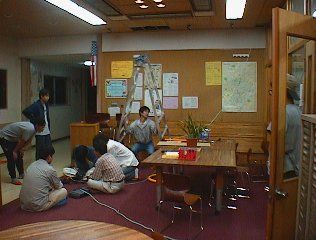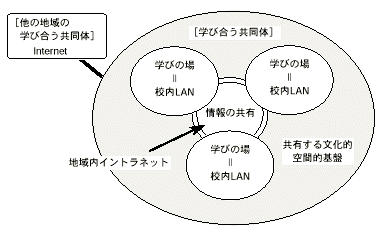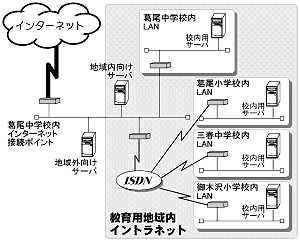Conference to introduce results from the 100-School Networking Project (Phase
II)
Theme meeting
Using the Internet at a Small Mountain School
—Developing a Community Network—
Masakuni Watanabe, Abukuma Area Collaboration Project
(Education Agency of Fukushima Prefecture)
e-mail:masakuni@katsurao-jhs.katsurao.fukushima.jp
e-mail:masakuni@abu.ne.jp
1. Introduction
 Katsurao Junior
High School is located in a remote region in the central Abukuma highlands.
The school began using a networking system for educational purposes since
the start of its participation in the 100-School Networking Project. This
junior high school has established and conducted research on a network with
the help of people not associated with the school.
Katsurao Junior
High School is located in a remote region in the central Abukuma highlands.
The school began using a networking system for educational purposes since
the start of its participation in the 100-School Networking Project. This
junior high school has established and conducted research on a network with
the help of people not associated with the school.
We would like to report on the present state of the Abukuma Area Collaboration
Project, and on some of its problems. This project began to network schools
in the Abukuma region and to promote collaboration between local schools and
the local community, with Katsurao Junior High School as the nucleus.
This project was designated as an "area collaboration project" in
the CEC-initiative program of part of the 100-School Networking Project (Phase
II) in 1997, and was launched to promote Internet use in the community.
2. The network environment at Katsurao Junior High School
2.1. Improving equipment and increasing use
- The 100-School Networking Project provided only a server and a client computer.
To give students better access, we established an in-school LAN ourselves
and purchased more client computers, with the result that computer use rose
among teachers and students.
2.2. Extending a human network
- Active Internet use creates new demands for a networking environment. School
staff and volunteers (people from the community related to the network) gathered
every month to discuss establishing a network to satisfy the needs of students
and teachers. The system continued to improve, based on requests from ordinary
users and lessons learned from our problems. Our hard work paid off, motivating
students and teachers to use the networks even more.
3. Using networks to study
3.1. Benefits of using the Internet
 Students became
more enthusiastic about studying after the Internet was introduced, and were
more eager and independent in gathering information they needed and in communicating
with people living outside the community.
Students became
more enthusiastic about studying after the Internet was introduced, and were
more eager and independent in gathering information they needed and in communicating
with people living outside the community.
3.2. Need for a regional intranet
- Because these regions share a common culture and geographic features, we
believe that connecting in-school intranets between neighboring areas will
promote communication, and create a community in which students can study
together.
In this virtual community, students are able to correspond with students from
other schools and to share information via the regional intranet, as shown
in the Figure on the right.
4. Establish a system for area collaboration
4.1. Conditions of a system
- An easy-to-operate networking system for needs to be established for schools.
We try to create a system meeting the following conditions:
1. Establish a LAN, server, and client computers within forty-eight hours.
2. Computers used by students and teachers use can be set up in similarly,
and should be immediately available for use after connection to an in-school
LAN.
3. Server and routers should have the capacity for remote control and maintenance.
We dubbed such an in-school LAN a "Net day pack," and have examined
and tested the following points:
a. Networking area schools.
b. A central computer to establish an in-school intranet.
c. A local server to establish an inter-school intranet.
4.2. Regional Intranet
 Our In-school
LAN is operated with a private IP address, and is connected to NOCLAN, which
is operated through routers with an global IP address. Routers connecting
each school LAN have provided routing information for each one and for NOC's
network, creating a complete intranet.
Our In-school
LAN is operated with a private IP address, and is connected to NOCLAN, which
is operated through routers with an global IP address. Routers connecting
each school LAN have provided routing information for each one and for NOC's
network, creating a complete intranet.
1. To control security, an NOC system administrator needs to worry only about
the server for outside the region.
2. Unsuitable information can be filtered through the NOC http proxy server.
3. By using different servers, users can choose the network to which they
want to send information.
4. Each school's system administrator needs to worry only about the school's
own server.
4.3. Structure of an in-school server
- In schools, teachers and students use ordinary personal computers running
Windows or the Mac OS. User interfaces should be in the metaphor provided
by these operating, to permit easy network use. Networking systems often have
many difficult setup procedures unfamiliar to users. The following functions
are useful in supporting users of an in-school networking system:
a. User interfaces should be provided in the operating systems' metaphor.
b. The computer/network connection should be as simple as possible.
c. All services should be accessible using one ID.
4.4. Testing the Net Day Pack
- We tested the relative ease of establishing a networking system using a
regional intranet and an in-school server. So far, we have tried this at three
schools in Fukushima Prefecture (Ogisawa Elementary School, Miharu Junior
High School, and Katsurao Elementary School) confirming that it is possible
to establish a network within forty-eight hours. I would like to discuss the
test outlines.
We finished setting up the server the day before we started. On the first
day, we prepared the tools required to build a network, with teachers and
community volunteers all working together.
Work schedule
a. Held meeting to go over procedures and to prepare teachers and volunteers.
b. Checked school facilities and did some basic prep work to establish an
in-school LAN.
c. Set up server and routers.
d. Established a LAN in the teacher's room.
e. Informed teachers how to use the network in the teacher's room.
5. Methods of supporting network use
- Now that we've talked about the test of establishing an in-school networking
system as a part of our area collaboration, let's discuss some support issues.
Installing Ethernet cables between community schools does not, in itself,
make networks ready for educational use. An important aspect of area collaboration
is frequent communication, both by using mailing lists and in person. Since
the people participating in this particular area collaboration project came
from Fukushima Prefecture and neighboring prefectures, frequent face-to-face
meetings are difficult. We made up for this by using mailing lists. We also
created opportunities for members to gather on Net Day and in seminars to
exchange ideas and information and to discuss problems.
As a result of our experiences, the Abukuma Area Collaboration Network Study
Group ins confident in proposing the following methods of supporting community
network use:
1. Establish a mailing list allowing daily exchange of ideas, problems, and
information.
2. Hold lectures, seminars, and social gatherings on a regular basis for people
throughout the community.
3. Make changes in the system to satisfy requests from schools.
6. Goals for the future
- Some people may think that establishing a networking system on Net Day is
not part of a school's responsibility. But doing so gives schools (normally
sharply separated from society) a chance to associate with the outside world.
Since the proposal of the Net Day Pack, equipment for in-school networks has
improved. The next phase of the area collaboration project should examine
how networks can be used to deepen and support children's study. In the establishment
of community networking systems, educators and technical experts have an important
role in promoting computer literacy and in transferring the appropriate technology
to the community.
Below are the Goals of the Abukuma Area Collaboration Network Study Group:
a. Establish a curriculum for seminars.
b. Write a manual on requirements for sponsoring Net Day.
c. Create a list of solutions for problems, by collecting real-world cases
and measures used to solve them.
d. Discuss how to run the networks by cooperating with volunteers in the community.
e. Increase computer literacy, and transfer the technology needed to the community.
Reference
- The Abukuma Area Collaboration Network Study Group http://www.abu.ne.jp/
Activity procedures http://www.katsurao-jhs.katurao.fukushima.jp/UGA/
Katsurao Village Katsurao Junior High School http://www.katsurao-jhs.katsurao.fukushima.jp/
Katsurao Village Katsurao Elementary School http://www.katsurao-es.abu.ne.jp/
Miharu Town's Ogisawa Elementary School http://www.ogisawa-es.abu.ne.jp/
Miharu Town's Miharu Junior High School http://www.miharu-jhs.abu.ne.jp/
 Conference to introduce results from the 100-School Networking Project (Phase II)
Conference to introduce results from the 100-School Networking Project (Phase II)
 Katsurao Junior
High School is located in a remote region in the central Abukuma highlands.
The school began using a networking system for educational purposes since
the start of its participation in the 100-School Networking Project. This
junior high school has established and conducted research on a network with
the help of people not associated with the school.
Katsurao Junior
High School is located in a remote region in the central Abukuma highlands.
The school began using a networking system for educational purposes since
the start of its participation in the 100-School Networking Project. This
junior high school has established and conducted research on a network with
the help of people not associated with the school.  Students became
more enthusiastic about studying after the Internet was introduced, and were
more eager and independent in gathering information they needed and in communicating
with people living outside the community.
Students became
more enthusiastic about studying after the Internet was introduced, and were
more eager and independent in gathering information they needed and in communicating
with people living outside the community.  Our In-school
LAN is operated with a private IP address, and is connected to NOCLAN, which
is operated through routers with an global IP address. Routers connecting
each school LAN have provided routing information for each one and for NOC's
network, creating a complete intranet.
Our In-school
LAN is operated with a private IP address, and is connected to NOCLAN, which
is operated through routers with an global IP address. Routers connecting
each school LAN have provided routing information for each one and for NOC's
network, creating a complete intranet. Conference to introduce results from the 100-School Networking Project (Phase II)
Conference to introduce results from the 100-School Networking Project (Phase II)